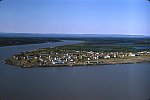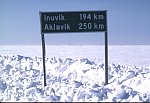Global Warming in the North:
Extreme Climate, Unpredictable Change
Author: Jennifer Jozic, Centre for Studies in Agriculture, Law and the Environment Page 1 | Page 2 | Page 3
Aklavik: Impact of Climate Change on a Northern Community
Residents in and around the town of Aklavik have recently become involved in a project that records their observations regarding climate change. Their input is valued because of their especially close relationship with the natural world. As they travel over the tundra or harvest fish from the sea, they notice even the smallest changes in their environment. Recently the changes have been significant and worrying. The climate has become unpredictable and the landscape is increasingly unfamiliar.
Aklavik is the most westerly community in the Northwest Territories and is found at the edge of the tree line, near the foot of the Richardson Mountains and not far from where the Mackenzie River flows into the Beaufort Sea. It is situated on a flat, muskeg-covered silt, hemmed in by the river, swamps and ponds.
It was once the site where the Inuvialuit and the Gwich’in (Dene) traditionally met and sometimes clashed in their search for food and furs. Early in the twentieth century the community became a principal location for trapping, trading and transportation in the Mackenzie Delta. The Hudson's Bay Company established a trading post at Aklavik in 1912. By 1918 Aklavik was a permanent settlement and the centre of a thriving trapping economy based on local muskrats and white fox from the Arctic. An Anglican mission was set up in 1919, and Aklavik became the headquarters for the RCMP in the western Arctic in 1922. A Roman Catholic mission was added in 1926.
During the winter of 1931-32 the RCMP, aided by Aklavik residents, used the settlement as a base for the most famous manhunt the Canadian North has ever seen. The pursuit of Albert Johnson, the "Mad Trapper of Rat River", ended after forty days when Johnson was shot and buried at Aklavik. He had covered hundreds of kilometres without provisions or a dog team.
By 1952 some 1500 people, as well as government services, were based in Aklavik. Mission hospitals and residential schools continued to attract people from the surrounding region but erosion of the Peel Channel banks had led to melting permafrost and severe flooding, prompting the Federal Government to construct Inuvik with the intention of relocating the Aklavik community. In 1961 most services and many residents were moved, but some decided to remain in their homes.
Petroleum exploration in the Mackenzie Valley and Beaufort Sea began in 1971 and continued through the next couple of decades. In 1990 petroleum companies temporarily withdrew in response to dwindling government subsidies, flagging oil and gas prices, and local resistance to industrial development. They resumed exploration for natural gas in the region a year later.
Today, Aklavik is a peaceful community of some 750 Gwich'in and Inuvialuit who harvest fish and muskrats. The town melds modern and traditional and the inhabitants are proud not to have jumped ship when they were invited to leave their sinking town for Inuvik in the 1950s. The Hudson's Bay Company post still exists along with a museum constructed out of a former mission church, but there is no restaurant and only one shop. From January to April Aklavik is connected by a winter ice road to Inuvik 112 km away. Water crossings are possible for a portion of the remaining year; therefore 90% of travel in and out of the region is via air.
Some of the observations regarding climate change that have been made by Aklavik residents include:
- Autumn freeze-up is occuring up to a month later than usual and spring thaw is erratic.
- The sea-ice is smaller and now drifts far from the community in the summer, effectively removing the seals, a staple of the community.
- In the winter the sea-ice is thin and broken, making travel dangerous for even the most experienced hunters.
- In the fall storms have become frequent and severe, making boating difficult. Thunder and lightning have been seen for the first time.
- Hot weather in the summer is melting the permafrost and causing large-scale slumping on the coastline and along the shores of inland lakes. The melting has already caused one inland lake to drain into the ocean, killing the freshwater fish. Around the town of Sachs Harbour it is causing building foundations to shift.
- Thawing permafrost and shorter winters impede the only ground transportation across frozen ground and water, increasing economic costs.
- Winter ice roads have required more maintenance and have closed earlier than usual.
- In some areas, the arrival of the animals and birds important for annual hunts has become disconnected from the timing of solar seasons.
- New species such as barn swallows, robins, and salmon have been spotted for the first time in memory.
To access the video that the International Institute for Sustainable Development and the people of Aklavik created, see: Sila Alangotok: Inuit Observations on Climate Change (external site, uses RealPlayer video)
Conclusion
Scientific evidence supports a trend of global warming and reveals that it is a very real problem for many ecosystems, including the Canadian Arctic and sub-Arctic. Northern communities are witnessing their local environments change before their eyes, and often not for the better. Their way of life and their livelihoods are threatened but the hardy and resilient people of Canada's northern communities will continue to adapt to this onslaught of change.
For more information, see:
-
Centre for Studies in Agriculture, Law and the Environment
http://www.csale.usask.ca/ -
Intergovernmental Panel on Climate Change
http://www.ipcc.ch/ -
International Institute for Sustainable Development
http://www.iisd.org/ -
Arctic Climate Impact Assessment
http://www.acia.uaf.edu/ -
Government of Canada Climate Change Portal
http://www.climatechange.gc.ca/english/
Articles:
-
CBC News Indepth: Climate Change
http://www.cbc.ca/news/background/climatechange/ -
“Climate Change and Arctic Sea Ice” Greenpeace Canada Online Archive.
http://archive.greenpeace.org/climate/arctic99/reports/seaice3.html -
“Sustaining the Future” Backgrounder. United National website.
http://www.un.org/ecosocdev/geninfo/sustdev/es&5sust.htm
For Kids:
-
“Arctic Algae Show Climate Change” Science News for Kids.
http://www.sciencenewsforkids.org/articles/20050309/Note2.asp -
Climate Change web page at Ecokids online.
http://www.ecokidsonline.com/pub/eco_info/browse_topics/environmental_issues.cfm




